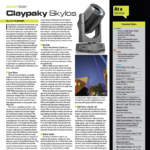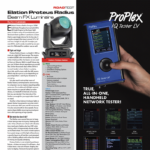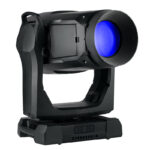The RC4Magic Series 3 system I received for review included the RC4MagicPC dongle, Series 2 DMXio Wireless Transceiver, Series 3 DMX2dim, DMX4dim, DMX2micro, and DMXi2c. This set of tools gave me three different transceivers, a four-channel wireless dimmer, and two different-sized two-channel wireless dimmers for various purposes. The dimmers can receive wireless DMX and drive DC-current powered lamps, LEDs, etc., ranging from 6V to 35VDC.
The entire system utilizes the common 2.4Ghz ISL radio band, and the transmitter chooses which channel in the wireless spectrum to use upon boot-up, scanning to find the least-trafficked to avoid interference. The RC4 system also sets itself apart from other products by utilizing Private IDs for each end-user system sold. Each device is given three unique hexadecimal ID strings. (The three IDs also give you the ability to use these IDs for three different universes of DMX.) These unique IDs mean the devices don’t respond to signals that aren’t specifically addressed to it.
I set several scenarios to simulate how the gear would be used generally. In the first, I hooked the transmitter to my lighting console, one receiver (DMX4dim) sending data output to dimmer rack, other receivers (DMX2dim, DMX2micro) acting as receiver data nodes for LED wash lights. This was to simulate a one-off gig situation where there’s no time or room for unsightly cable runs or a lengthy home run from console to fixtures. In the second setup I kept the transmitter hooked up to a lighting console, used DMX4dim to run DMX LED tape and had the DMX2dim running some MR16s. This was to simulate a theatrical setup where wireless data is needed for battery-controlled props and scenic/costume lighting. In my third scenario I wanted to simulate a multi-room interactive media experience where versatility and minimal footprint is key. I used a DMX node (MA onPC Pro node) to send data to receiver units placed in various places across a multi-room venue, with some doorways and walls in between (no brick or cinder block, just hollow walls w/ studs). LED tape, dimmable LED lamps and MR16s were hooked to each receiver, with additional LED wash lights and a few GLP impression wash moving lights daisy-chained out of the receivers as well.
I wanted to test just how robust the wireless was, so I set it up in an environment that used a Wi-Fi system known to actively flood foreign wireless networks with packets to shut them down. Despite the best attempts of the system, I had zero issues with lag or interference while using the RC4 Wireless system.
I also had zero issues with dropouts. RC4 touts that as long as you are working within the confines of 250-foot point-to-point distances between your transmitters and receivers, you will not have any issues with dropouts. This was my experience, and I was impressed by the ability of the receivers to maintain signal through walls and doors — especially since the transceiver is the only box with an actual external antenna. (The tiny receivers have built-in antennae.) Dimming and DMX transmission rates were excellent, without any hiccups or noticeable flickering even while moving the pieces between rooms.
But There’s More…
RC4MagicPC software (Windows only) really unlocks the power of the system, allowing complete configuration of user ID’s, dimmer curves, channel assignments, LED frequency and virtual DMX control — to name just a few of the tweaks you can make. To do this, you plug the RC4 MagicPC dongle into your USB port and start the software. From the program you can access any of your RC4 devices. I found the initial setup and discovery process to be a bit complicated, though, and reading the start-up tutorials is highly recommended to avoid confusion.
Once the system is configured and running, operation was seamless. I was able to access and configure each piece of my Series 3 with a variety of dimmer curves to change the desired look of my fixtures. This is a great feature, since it meant my LED sources could be curved at the dimmer to closely match the look of incandescent sources. From the RC4MagicPC software, the PWM frequency of the dimming outputs can even be changed to provide ultra-smooth and flicker-free dimming for LED tape or lamps.
Another feature available through the PC software is HSL matching of different LED products. You can set a white point for each dimmer, which will then curve each source appropriately to match, something crucial in the modern day world of LEDs which often need little adjustments to truly match colors. In fact, RC4’s HSL curving provided some of the smoothest LED dimming I have ever seen, both in person and on-camera. The ability to change PWM of the dimmers enables interfacing of LED products for film and TV environments, where absence of on-camera flicker is critical.
But even without using the PC software, you can still configure the RC4 equipment via tiny buttons on the units themselves. A paperclip will be your best friend here — much more helpful than the Microsoft Office paperclip of old, but at times equally frustrating when it comes to clicking tiny buttons. Dimmer channels and curves can be assigned by pressing one of the dimmer buttons on a unit and bringing up the desired channel on your lighting board. This is called RC4 OneTouch and it is a very easy feature to get things up and running quickly. Selecting various modes, like HSL mentioned above, can also be assigned in this same manner by using a combination of the function and dimmer buttons. The devices’ private IDs are also set upon boot by using the paperclip method and reading the start-up sequence of the LEDs.
Another cool feature of all the units is that any of the units can also send or receive hard-line DMX by using stereo-plug to 5-pin DMX adapters from RC4, giving you multiple ways to get small runs of DMX to odd positions if needed.
I did have some usability issues* with the system — at times my PC would not connect with the devices through multiple restarts; the initial start-up and configuration was somewhat confusing due to so many options; and the use of paperclips for setting devices at times left me wishing for another set of hands. A Mac version of the PC app would be great too, although BootCamp works just fine. (See sidebar).
But despite these difficulties, once the system is up and running, it is virtually seamless and very easy to use. The tutorial videos and manual that RC4 has put together are an excellent resource in getting to know the product, and is crucial to getting the full power out of the system. Once you do, your imagination can take over. Over the course of my time with the RC4 system, I continued to dream up more and more scenarios where I could spec such a system: dimmable, controllable EL wire built into costumes for dancers; flying scenery and props that can run complex chases and reliably work untethered; interactive large-scale multimedia installations spanning tens of thousands of square feet all tied together by DMX. The DMX2micro and DMXi2c allow integration of wireless DMX and dimming into tiny handheld props, and work with processors like Arduino and Raspberry Pi, where it’s traditionally been too difficult or expensive. The stereo to DMX adapters allow these to also pass DMX data to other devices. I’ll definitely be playing with these in the future on some of my multimedia and interactive art explorations.
At a Glance
Zeroing In on Specific Devices for Control
RC4 Wireless’ RC4Magic Series 3 is a highly configurable, multi-functional and powerful set of tools that can help backstage pros gain control over their devices without running cable everywhere. Using the 2.4Ghz ISL radio band and unique “IDs,” the system is designed to zero in on the specific devices that need to be controlled and blithely ignore all the other RF chatter out there.
Although our reviewer had some issues (See the asterisk * in the main story), RC4 Wireless’ James David Smith noted that the problem he encountered is a rarity and can be easily resolved so that it will never be encountered again. (See “A Note on the PC’s “Learning” Curve, below).
Pros: Robust and secure wireless, great HSL curve dimming; lots of uses (dimming, motor control, prop integration)
Cons: Small buttons for settings; “lots of uses” means “involved setup”
Manufacturer: RC4 Wireless
More Info: www.theatrewireless.com
*A Note on the PC’s “Learning” Curve
[We gave James David Smith, president and chief product designer at RC4 Wireless, a chance to respond to our reviewer’s “usability issues” (asterisked *, in main story, this page). His response follows. — ed.]
Our RC4MagicPC dongle uses an industry-standard USB communications chip, the drivers for which are available through Windows Update. This usually means that installation is quick and easy, with no need for users to install proprietary drivers. Occasionally, however, driver problems do arise, and I suspect this is what happened to the reviewer. In particular, we note in our video tutorials and documentation that manual driver installation is recommended when using a Mac with BootCamp or Parallels.
Separate from that is the initial start-up and configuration process. What the reviewer is referring to is getting the PC to “learn” the user’s private RC4 system IDs. This is done only once, after which the PC remembers them.



